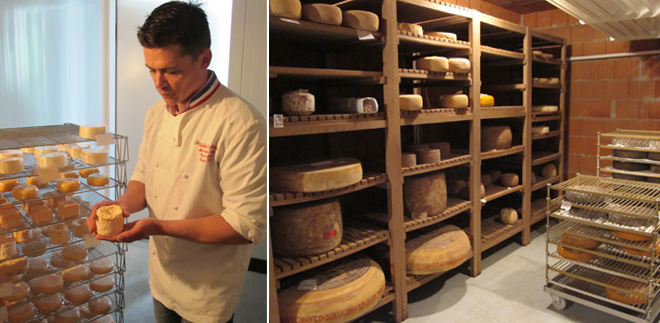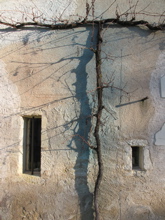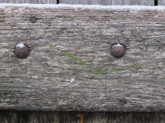

Back and forth, hither and yon – whether on my habitual trajectory between Touraine and Paris or further afield… destinations, encounters, events and observations I can’t resist sharing.
I asked Rodolphe to suggest four varieties to create a cheese plate for a dinner party. French cheese is classed into five main families, so I was limiting him somewhat. He might have preferred I said five, so he could pick one from each family.
Rodolphe begins by saying “At that time,” meaning “at this time of year (i.e. spring),” and goes on to propose several options for each of the first three selections.
Suggestions by family :
Chèvre/Goat – Couronne de Touraine or Pouligny.
Croûte Fleurie/Soft Ripened – Saint-Félicien, Saint-Marcelin or Brie de Meaux.
Pâte Pressée cuite ou non cuite/Cooked or Uncooked Pressed – Comté (cooked), Salers (uncooked), or Saint-Nectaire (uncooked).
Bleu/Blue or Croûte Lavée/Washed – For the fourth recommendation, he suggests including either a blue such as the Roquefort he has on the plate in front of him, or a washed (pronounced wa-shed in the film). Munster, Livarot, Maroilles and Epoisses are from the washed (croûte lavée) cheese family. They tend to be golden or orange in color and have a pungent aroma, although the taste is not as strong as the aroma suggests.
His specific recommendations for another time of the year would be different but he would still select one cheese from each family.

Along with wine making, the French cheese industry is undergoing a back to basics renaissance, marked by renewed appreciation for authentic flavor and organic process. As with natural wine production, which respects the idiosyncrasies and inconsistency of terroir, a new generation of cheese producers, refiners and sellers are putting science back in service of nature.
Rodolphe Le Meunier epitomizes the new vanguard. At 35, he doesn’t have much left to learn about cheese. Since 2007, he’s collected an impressive set of awards, including Meilleur Ouvrier de France, which is the gastronomic Pulitzer for food artisans, and the International Caseus Award – the Olympic gold of the cheese world.
He and his sister Caroline are the third generation to run Les Fromages du Moulin in La Croix en Touraine, between Tours and Amboise. Instead of making goat cheese and selling it at local markets as their grandmother did, Rodolphe uses his expertise to identify the best French and European cheese, which he then ages in cold storage until it’s ready to be sold. To guarantee that every cheese arrives at its destination in perfect condition, Rodolphe added a distribution and export business – From’europe – located in the Rungis wholesale market outside Paris.
Le Meunier has a profound appreciation for how well nature gets the job done if the conditions it requires are respected. The title affineur (refiner or cheese ager) gives a false impression of his role, since cheese matures with or without human intervention. His job is to create the optimum environment by controlling temperature, humidity level and air circulation, all the while carefully surveying how things are progressing. “It’s the same with wine. Storing it in an insulated wine cellar will produce better results than allowing it to age in a warehouse where temperature and light isn’t controlled. Either way, the wine in the bottle continues to evolve, but one will taste much better than the other.”
Like French celebrity chefs and winemakers, Le Meunier is leveraging his reputation to diversify his business and expand reach. Increasingly, the cheese and butter he exports to New York and Japan are marketed under the Rodolphe Le Meunier brand. The classic package design features a label with his signature, three gold fleur de lis and the distinctive MOF medal. Among his American clients is Wegmans, an 80-store mid Atlantic food market, ranked by the Food Network and Consumer Reports as America’s best grocery chain.

Le Meunier cheeses are produced in partnership with select cheese makers he’s identified as best in their class. Few producers he’s approached have turned him down. His partners are pleased to be singled out by a discerning judge in a field crowded with competitors. Le Meunier functions as product development and marketing consultant as well as distributor. His association permits independent producers to introduce their cheese to markets they otherwise wouldn’t have the opportunity or inclination to reach. “There are so many wonderful French cheeses that aren’t consumed outside of France. Certain goat, sheep and soft ripened cheese are tricky to export because they need to stay moist yet breathe in transport. The solution is airfreight but even then you can’t risk delivery taking more than three days.” He also sells to French supermarkets, but circumvents the distribution chain, which can be fatal for fragile cheese, by delivering direct to stores.
If you’re a cheese lover like I am, it’s an infinitely fascinating subject and I arrived at our meeting with tons of questions and a fair number of, as it turns out, wrong assumptions. The first myth dispelled is that buying cheese with the AOC label (Appellation d’Origine Controllé) or AOP as its EU name has become (Appellation d’Origine protégée) is an assurance of quality. “AOP tells you a cheese is made in a certain location using a particular method, but guarantees nothing in terms of quality. It’s the quality of milk used and who is makes the cheese that determines whether it’s good. Again, like wine, there are great cheeses without an AOP label, and inferior cheese with one.”
Mold is a good sign on ripening cheese. “Fuzz is natural. If it doesn’t grow on the skin of cheese, it’s pasteurized. On a soft ripened cheese like Saint Marcellin, it’s so fine you don’t see it but it’s there.” You might not like the taste, but it’s perfectly ok to eat – it’s a question of preference. “Some people don’t like the rind on Brie, but if the cheese is a good one, it’s delicious.”
Not every cheese needs to breathe while aging. Some washed rinds like Maroilles or Epoisses, are aged wrapped in plastic, to make them creamier. Even so, the cold storage room for this cheese family had a particularly pungent odor. The aroma of the goat cheese room was also memorable, but the cold chamber lined in Austrian terra cotta bricks where his pressed cheese age, was pleasant.

In Catholic parishes where I attended mass before moving to Orbigny, Christmas and Easter services were the big draw, but in rural Touraine, it’s Palm Sunday that really fills the pews. Considering it’s a lengthy service including the longest gospel reading of the year, I was amazed to see our typically sparsely filled church packed to capacity with men, women and children clutching bunches of boxwood clippings. Among the faces were avowed agnostics and vociferous anti-clerical types whom typically cross the threshold only for a funeral. This wasn’t about an excuse for dressing up, since Sunday go-to-meeting preening isn’t something the French go for even on holidays, with the exception of a wedding.
I suspected the swell in attendance was linked to a primeval sentiment beyond piety – the power of ingrained tradition and superstition to overpower cynicism and skepticism. But why boxwood instead of palm fronds?
In French, the feast is called Dimanche des Rameaux (Sunday of Branches). No mention of Palms. Boxwood, or buis, is a hardy evergreen plant that requires little watering and thrives in the alkaline clay soil of the region. You find it throughout Touraine, growing as a tree in the forest, a trimmed hedge or bush in cottage potagers, or sculpted into fantastic topiaries in chateaux gardens. Thus it’s readily available, unlike palms imported from the southern Mediterranean. In the UK and US, pre-blessed palms, typically woven into the shape of a cross, are distributed as congregants exit the church. Here we hold up boxwood cuttings from our gardens (or a supply set out on a table by the entry of the church), as the priest walks up and down the aisles blessing the congregation with holy water.
A few years back, while out riding my horse, I came across a farmer and his wife on their knees planting a sprig of buis in the plowed earth at the corner of their field. The spot is a local landmark known as Les Trois Croix, for three crosses erected at an intersection of four fields, where the boundary limits of three villages meet. It’s also the highest point in the county, and seemed an apt setting for a ceremony with echoes of pagan ritual. That was my aha moment and confirmed my hunch about the superstitious appeal of blessed buis. Read More »
 |
 |
 |
 |
 |
 |
 |
 |
 |
 |
 |
 |
 |
 |
 |
 |
 |
 |
 |
 |

…into a silken slice of ambrosia.
‘Tis the season of gourmet delicacies – truffles, oysters and foie gras – perennial stars of les fêtes de fin d’année. The seductive/repellant duality of these acquired tastes is undeniable. There’s an unsettling aspect either to their appearance, texture or how they are produced, which heightens the guilty pleasure of consumption; earthy truffles detected by a pig’s snout, fresh oysters ingested essentially alive, and the incomparably subtle flavor of a force-fed duck’s swollen liver.
Working on French Country Hideaways, which features several properties that produce foie gras and truffles, I stopped short of hands-on involvement. So when friends proposed an atelier foie gras offered by Maison Perrin, a small Touraine producer, I was all in. I always found purchasing foie gras a challenge with so many variations and pricing inconsistencies. Numerous French friends prepare it at home, but I envisioned a complicated ritual.
Maison Perrin is a farm in La Celle Guenand, near Le Grand Pressigny, owned by Valérie and Philippe Charcellay. Its remote location conjured images of a convivial country kitchen with our intimate group gathered round a worn trestle table scattered with earthenware terrines, warmed by the glow of an open hearth. The destination conformed to expectation, as did a modest shop with hand woven baskets suspended from the ceiling, shelves stocked with conserved duck dishes from cassoulet to rillettes and a cold case stacked with vacuum-packed magrets, lobes of foie and jars of foie gras mi-cuit. Maison Perrin
It was startling to discover that the idyllic kitchen was actually a chilly white tile and stainless steel laboratoire, where to match EU standards, the ambiance exuded the charm of a hospital canteen annexed to a morgue. Comfort was not to be part of our experience. The temperature had to be 50 degrees Fahrenheit. I regretted forgoing the long underwear and fur-lined boots I’d considered because of snowy weather. Gloves weren’t an option, but mercifully we got to warm our hands intermittently under a steamy tap.

When I moved to NYC after college, the impossible dream was to take over the lease on a rent-controlled apartment. Rent control symbolized mythic, affordable Manhattan before housing ate up half a paycheck – the stuff of urban legend. I never got lucky.
Well, every dog has its day, and I can finally gloat in my rural backwater that I’m grandfathered into EJP, a bargain electricity option which EDF (formerly known as Electricité de France) no longer offers because it’s far too good a deal for the consumer. I’m tempted to be smug, except EJP is a blessing disguised as a curse, and it was more fun when you could bitch about it. Now complaining you can’t do laundry or use your electric oven because it’s an EJP day is considered obnoxious.
EDF created the EJP (Effacement des Jours de Pointe) option for secondary residences, where cold weather consumption occurs (if at all) on weekends and holidays. They offered a very low annual rate, excluding the 22 coldest weekdays of the year, when national consumption peaks and the EJP rate correspondingly spiked. Where EDF miscalculated, was promising not to include weekends, school holidays and the wee hours between 1am and 7am. Read More »

May is when things get going in the potager. The first radishes plump up, baby lettuce, arugula and spinach are lustrous and strawberries begin to ripen.
Our potager is a bit of a laggard because of a predominantly northern orientation (along the fence line), with southern light filtered by an ancient hawthorn hedge that developed into a row of trees. Read More »
© Copyright 2026 Casey O’Brien Blondes - Privacy Policy | Design by Weller Smith Design
Do NOT follow this link or you will be banned from the site!